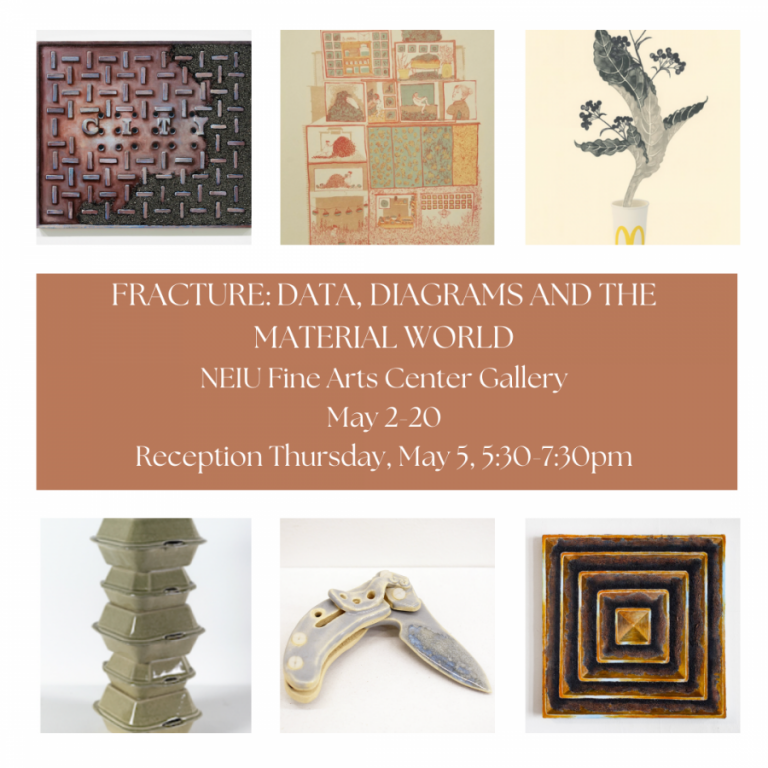FRACTURE: Data, Diagrams and the Material World
@ NEIU Fine Arts Center Gallery
5500 N St. Louis Ave, Chicago, IL 60625, Building E
Opening Thursday, May 5th, from 5:30PM - 7:30PM
On view through Friday, May 20th
NEIU Fine Arts Center Gallery
Artists
Yoonmi Nam
Giovanna Pizzoferrato Ribeiro
Christina Kang
Jonah Hoffman
Curated by Millicent Kennedy
Northeastern Illinois University Fine Arts Center Gallery is pleased to announce upcoming exhibition Fracture: Data, Diagrams and the Material World. The four artists featured measure, mediate, negate and reflect on our relationship to objects and our environment. From mouse traps and plastic bags, to manhole covers and datapoints, these artists shift perception of the commonplace.
The artworks in Fracture relate to sewer grates, plastic cups or instruction manuals. They are subjects that usually exist in the language of design, but are intentionally redirected. Questioning the visibility of our daily landscape. Through painting, drawing, printmaking, and sculpture these artists’ offer poetic viewpoints on how we make sense of the flood of information, materials and other people in the built environment.
Fine Arts Center Gallery, Northeastern Illinois University
5500 N St. Louis Ave, Building E, Chicago, IL 60608
Exhibition Dates: May 2 – 20, 2022
Reception: Thursday, May 5, 2022 5:30-7:30pm (Artist Talk at 6:00pm)
Gallery Hours: Monday & Wednesday: 10:00-5:00
Tuesday & Thursday: 11:00-4:00
Friday: 11:00-2:00
Yoonmi Nam is interested in the ever-shifting stage of the ephemeral. Nam is drawn to man-made spaces and objects that we surround ourselves with, and how they give a sense of time that seems both temporary and lasting. Some works feature arranged flowers with fleeting lifespans are elaborately arranged placed in disposable vessels, a yogurt cup, a Styrofoam take-out box, and an instant noodle bowl. These throwaway objects and cut flowers engage in a dialogue that speaks about impermanence and persistence. These single use items reproduced by hand as lithographs and ceramic objects, highlight the cultural prevalence of designed waste, but also the still life assembled creates a strikingly contemporary sense of memento mori.
Giovanna Pizzoferrato Ribeiro’s paintings and drawings are observational, not only drawn from life, but guided by curiosity in the selected subjects. Pizzoferrato Ribeiro’s practice investigates how objects function, and how they reference the body. She is driven by her curiosity about how things work or don’t work mechanically, as a way to contemplate the complicated creatures that we humans are. These specific sets of works, shooting targets, and mouse traps record the objects faithfully, making them not unlike a still life, but in their new context allow the viewer to consider their driving functions or lack thereof.
Christina Kang’s work is inspired by instructional imagery, specifically on food wrappers such as instant ramen noodles, frozen dumplings, and other Asian grocery finds. These instructions mirror the ‘model minority myth’ historically applied to Asians and Asian Americans in the United States; regarded as intrinsically successful, unfairly contrasted against other minorities and marginalized communities to further racial and political divisions.
Similar to how instructions are intentionally simplified for a broader audience, identities are flattened by the model minority myth and the resulting racist conclusions become reductive stereotypes. Kang’s work portrays specific and difficult to follow instructions, breaking out of the traditional paneled structure, and using objects that are personal and specific. Cumulatively this is a language in which the artist addresses her upbringing and privilege, how it contributes to the model minority myth and how it can be subverted.
Paintings and drawings by Jonah Hoffman are boundaries; utility covers, fences, and vents, that speak to the socio-economic landscape of Chicago. Referencing locations that are significant to the city’s history of racist zoning laws, discriminatory housing practices, and gentrifying development projects. He borrows from the tradition of trompe l’oeil, a painting form that causes viewers to see the flat painting surface as a space containing objects. He also emphasizes perspective, as it relates to the viewers perception of the subjects, topography, and visceral texture. Hoffman does not want you to just see the places in his paintings, he wants you to feel them.
Official Website
More events on this date
Tags: Chicago, Christina Kang, FRACTURE: Data Diagrams and the Material World, Giovanna Pizzoferrato Ribeiro, Jonah Hoffman, millicent kennedy, NEIU Fine Arts Center Gallery, Yoonmi Nam

« previous event
next event »